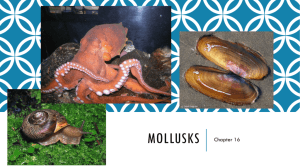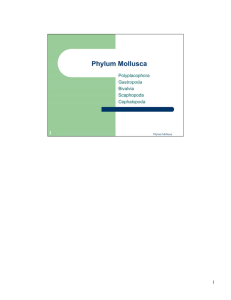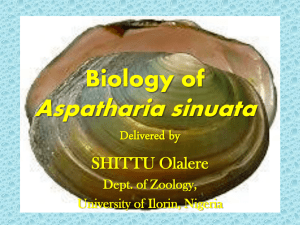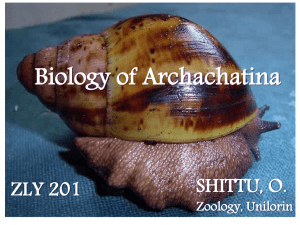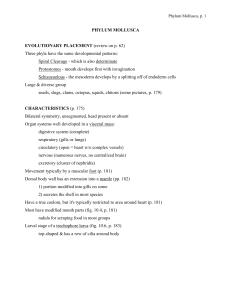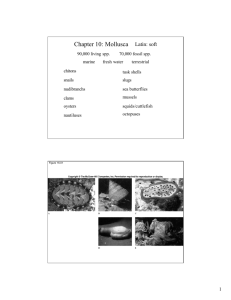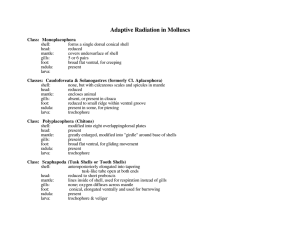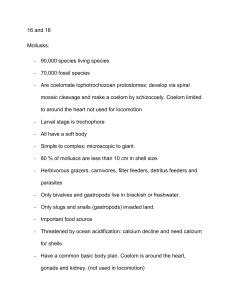Molluscs A. Introduction
advertisement
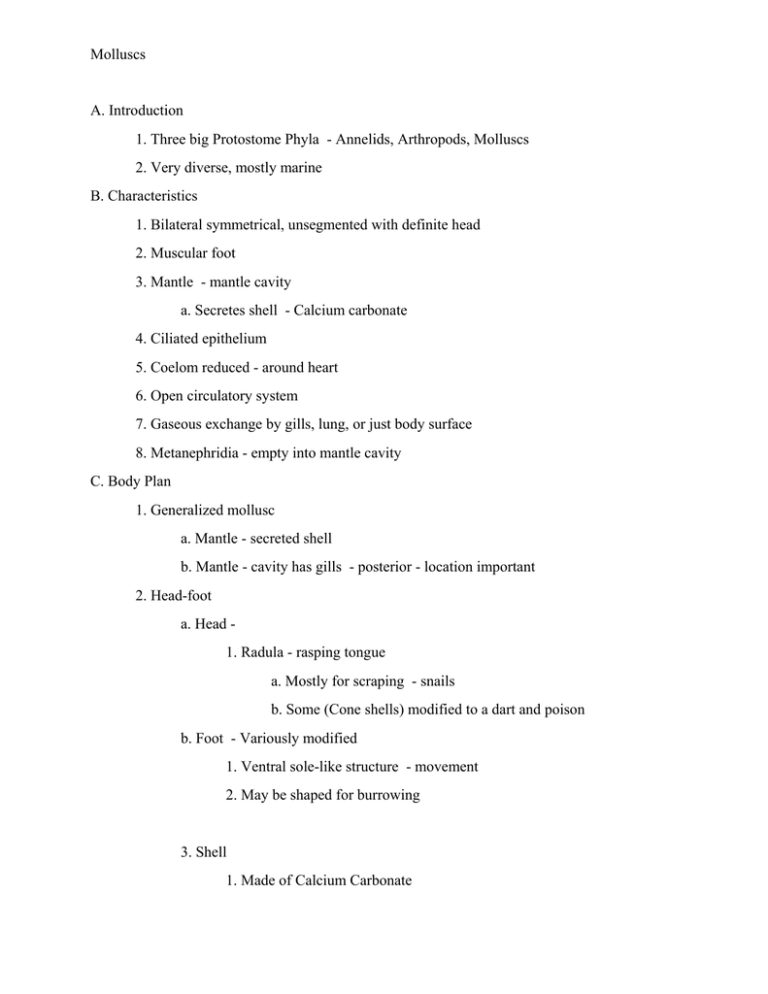
Molluscs A. Introduction 1. Three big Protostome Phyla - Annelids, Arthropods, Molluscs 2. Very diverse, mostly marine B. Characteristics 1. Bilateral symmetrical, unsegmented with definite head 2. Muscular foot 3. Mantle - mantle cavity a. Secretes shell - Calcium carbonate 4. Ciliated epithelium 5. Coelom reduced - around heart 6. Open circulatory system 7. Gaseous exchange by gills, lung, or just body surface 8. Metanephridia - empty into mantle cavity C. Body Plan 1. Generalized mollusc a. Mantle - secreted shell b. Mantle - cavity has gills - posterior - location important 2. Head-foot a. Head 1. Radula - rasping tongue a. Mostly for scraping - snails b. Some (Cone shells) modified to a dart and poison b. Foot - Variously modified 1. Ventral sole-like structure - movement 2. May be shaped for burrowing 3. Shell 1. Made of Calcium Carbonate Molluscs 2. Three layers a. Periostracum - organic layer - not always visible b. Prismatic layer - prim-shaped crystals of calcium carbonate 1. Secreted by gladular margin of mantle 2. Grows as animal grows c. Nacreous layer 1. Continuously secreted by mantle on interior of shell 2. Pearls 4. Reproduction a. Larval stages 1. Trochophore - first stage to hatch from egg 2. Veliger - planktonic larva of most marine snails and bivalves a. Beginnings of foot, shell and mantle D. Classes - problem of segmentation - is it the original body plan - have molluscs lost segementation? 1. Monoplacophora - genus Neopilina a. Serial repetition in body form b. Single shell c. Interesting story of discovery 2. Polyplacophora - chitons a. Segmented shell - plates b. Multiple gills down side of body - not like generalized plan c. Rock dwellers that use radula to scrape algae off rocks 3. Gastropods - snails - very diverse a. One-piece shell - may be coiled or not b. Torsion 1. Depart from original body plan 2. Body is massively twisted - whole body rotated Molluscs 3. Brings mantle cavity to front - problem of fouling - tough to get wastes out of mantle cavity 4. Why torsion - unclear - use mantle cavity as escape c. Fouling problem 1. Solved by having a 1-way flow through mantle cavity d. Feeding habits 1. Radula a. Mainly rock scrapers b. A few are predators 1. Radula is rasp to cut hole in other molluscs 2. Radular dart in Conus 4. Bivalvia - Bivalves - Clams a. Feeding - filter feeders - ciliary currents 1. Cilia on gills produce current b.. Shells 1. 2 shells - attached at ligament called umbo 2. Held together by 2 big muscles - adductors - close shells c. Locomotion - pulled down by slender muscular foot d. Reproduction 1. Mostly planktonic larvae - freeswimming trocophore and veliger 2. Freshwater Mussels have Glochidia e. Ecology 1. Bivalves are adapted to burrowing into soft substrate 2. Extend siphons to draw water into shells and filterfeed 3. A few live on substrates with strong organic cords called byssal threads - marine mussels and Zebra mussel 5. Cephalopoda - squids and octopus Molluscs a. Real contrast with other molluscs. 1. Very active and intelligent 2. All marine 3. All active predators - squid very fast swimmers 4. For most (exept chambered nautilus) the shell is much reduced or gone - shelled cephalopods are all long extinct 5. Tentacles with suckers b. Locomotion 1. Jet Propulsion - ventral funnel - expell water 2. Squid swim - lateral fins - streamlined built for speed - midwater predators 3. Octopus are benthic and live in crevices on seabottom c. Color changes 1. Really strong color changes to fit environment or to communicate a. Chromatophores d. Vision - very good 1. Eye is an analogue of vertebrate’s
